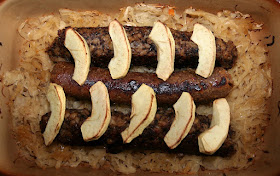 Last Sunday I got to see a Unesco world heritage site called Sammallahdenmäki. It's a Bronze age burial site that was used for a thousand years. Nowadays it's a beautiful granite hill covered by colourful lichen species and a few dwarfy pines but in the beginning of the construction it must have looked completely different. The place used to lie on a seashore and the climate was subboreal, meaning the temperatures were much like those that Central Europe now enjoys. Pine hadn't arrived yet and nut trees were fairly common. Weirdly, we know more about the religious views and language of those people than such tangible things like what they ate. Judging from what was available it might have been much closer to what dietitians recommend than a typical nutrition of today, at least during the good years.
Last Sunday I got to see a Unesco world heritage site called Sammallahdenmäki. It's a Bronze age burial site that was used for a thousand years. Nowadays it's a beautiful granite hill covered by colourful lichen species and a few dwarfy pines but in the beginning of the construction it must have looked completely different. The place used to lie on a seashore and the climate was subboreal, meaning the temperatures were much like those that Central Europe now enjoys. Pine hadn't arrived yet and nut trees were fairly common. Weirdly, we know more about the religious views and language of those people than such tangible things like what they ate. Judging from what was available it might have been much closer to what dietitians recommend than a typical nutrition of today, at least during the good years.One food preparation method that was very likely used intensively was fermenting. And as a food enthusiast I of course want to learn how to do that myself. After all, fermented dishes are still something that everybody should eat on a daily basis and the commercially produced ones tend to be spoiled by pasteurizing. The classic to start with is naturally sauerkraut.
This doesn't really require a recipe but I'm going to tell you how I made it anyway. There are varying instructions out there and my chemistry knowledge is scarce so I can't really tell which ones are based on actual evidence and which are more like folklore. That's why I try to explain just the guidelines and leave the experimenting for you.
(That miserable greyness in the photo is by the way the view from my kitchen window at noon. That's the brightest it gets right before winter solstice.)
- 1 cabbage head
- 2 carrots (or other veggies)
- 1 tablespoon caraway (or other spices)
- 1 tablespoon salt
Grind or shred the cabbage and the carrots. Add the caraway and the salt. When the cabbage starts to sweat (because of the salt) start beating it with any mallet or jar available. The idea is to get so much juice out it covers the cabbage. If the cabbage has already seen it's best days it may be so dry that this never happens. In that case dissolve some salt into boiling water, cool down and pour over the cabbage.
Put the cabbage with its juices into a clean and airtight vessel (I just use glass jars with a weight on top). Press the cabbage below the juice level so it won't touch the air and rotten instead of lacto-fermenting anaerobically. Let your forthcoming sauerkraut sit in room temperature from 3 days to 6 weeks depending on how strong you want it to be. The reason for moving it into a colder storage place after couple of days in some recipes is to slow down the process. Notice the vessel will flood over unless there's a lot of empty space left. Sometimes mold appears on top but this isn't dangerous ‒ just peel it off.
When sauerkraut has stopped bubbling it should taste pleasantly tart. Don't eat if it has turned soft. The taste matures for about six months if stored well in cool temperature (like fridge). If you think it tastes too sore rinse with cold water before eating. Sauerkraut can be used as a salad, in green smoothies or even in hot dishes (though heating of course destroys the largest health benefits). It's a good habit to always add a spoonful on your dinner.
Nutritional values / 1730 g (counted from the ingredients, also see Fineli):
energy 534 kcal
fat 3 g
protein 19 g
carbohydrates 102 g
fiber 37 g











